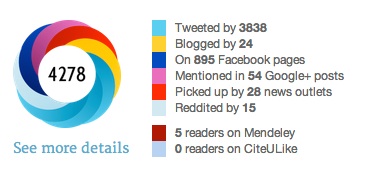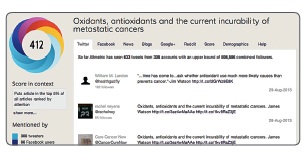Altmetric: a guide
You'll have noticed that on your Kudos Hub and Article Metrics pages alongside usage data, there is also a section detailing altmetric activity for your paper. But what are altmetric, and what do they show?
The concept
Altmetric have evolved to provide a new measure of the impact and reach of an individual article. In an attempt to move away from citation based criteria for assessing how a paper performs, altmetric provide a tool for tracking the wider dissemination of a paper within and beyond the academic community.
What's included?
Altmetric (who provide the data to Kudos) track mentions and shares of research papers across news outlets, social media (including Twitter and Facebook), blogs, bookmarking sites and post-publication peer review services.
Those mentions are then collated and displayed via the Altmetric donut. The colors of the donut represent the sources in which mentions of the paper were found (red for news outlets, blue for Twitter, and so on), and the score in the centre gives a guide to the overall attention an article has received.

The score is determined by an algorithm which takes into account 3 things:
- Volume - the number of mentions
- Source - the quality of the source of the mentions (for example, a BBC news article will have a higher weighting that a retweet)
- Author - the author of the mention changes the weighting given to each mention - someone who is considered an influencer within a community will receive a higher weighting that someone who is not.
You can click on the donut to view the original mentions of each article. For journal articles where the publisher has licensed the Altmetric data, you will see all of the original data. For those where they have not, you will see just the first 3 mentions in each category.

But how does it work?
Servers scan a curated list of sources for mentions of academic research articles by looking for DOIs or other unique identifiers (such as PubMed or Arxiv IDs).
Altmetric are able to disambiguate between different versions of an article - meaning that if it is available in a repository as well as on the publisher site, all versions of the article will be aggregated into one.
For news outlets a text-mining mechanism is also used, which helps identify mentions of an article even if it does not feature a direct link.
Oh, ok. Who cares?
Funders and institutions are increasingly looking for better ways to represent the impact that their research is having on wider society. Using altmetric can help identify key thought leaders in a field, and offer insight into the 'ripple effect' of the published article.
Including your altmetric data in your CV or sharing it with your peers can help raise your profile and give readers a more complete picture of the attention that your work has received.
I've got a score of 364. Is that good?
It is important to remember that the Altmetric score focuses on quantity, not quality. These measures are intended to be complementary to citation and download analysis, not instead of. The score is in no way an indicator of whether or not an article is good or bad, it is merely a measure of attention.
To help give you some idea of how your paper has performed amongst others of a similar topic or age, you can click on the donut and navigate to the 'score' tab. This tab gives context to the amount of attention your article has received when compared to articles of the same age/and or articles in the same journal.
How can I improve my altmetric score?
Sharing and promoting your research article needs to be more about making sure your work is being seen by anyone who might find it interesting and useful, and less about encouraging irrelevant activity just for the sake of it. You might like to consider sharing links to your paper via twitter or another social media platform, or working with your institution's press office to encourage wider coverage.
Why is my score fluctuating?
Altmetric.com provides Altmetric scores to Kudos for us to display within the Kudos site. Altmetric.com may revise their scores for a number of reasons, for example they may detect a spam mention and remove those, or a Twitter or Facebook user may choose to delete their own post. Occasionally Altmetric.com may review posts and reclassify them to a more appropriate category - most often a news story to a blog, and it can happen that Altmetric.com need to de-duplicate two versions of a blog post (where one is a slightly edited version of the first).
The Altmetric score is based on a weighted algorithm which takes into account the author, source, and volume of the mentions. Rarely, but for example when Altmetric.com add a new source, they have a need to rework this algorithm, which can effect the overall score for a paper.
Mentions of my paper seem to be missing
If you notice that some mentions of your paper are missing, and you think they should be there, you can email support@altmetric.com with the missing links.
To find out more visit www.altmetric.com
